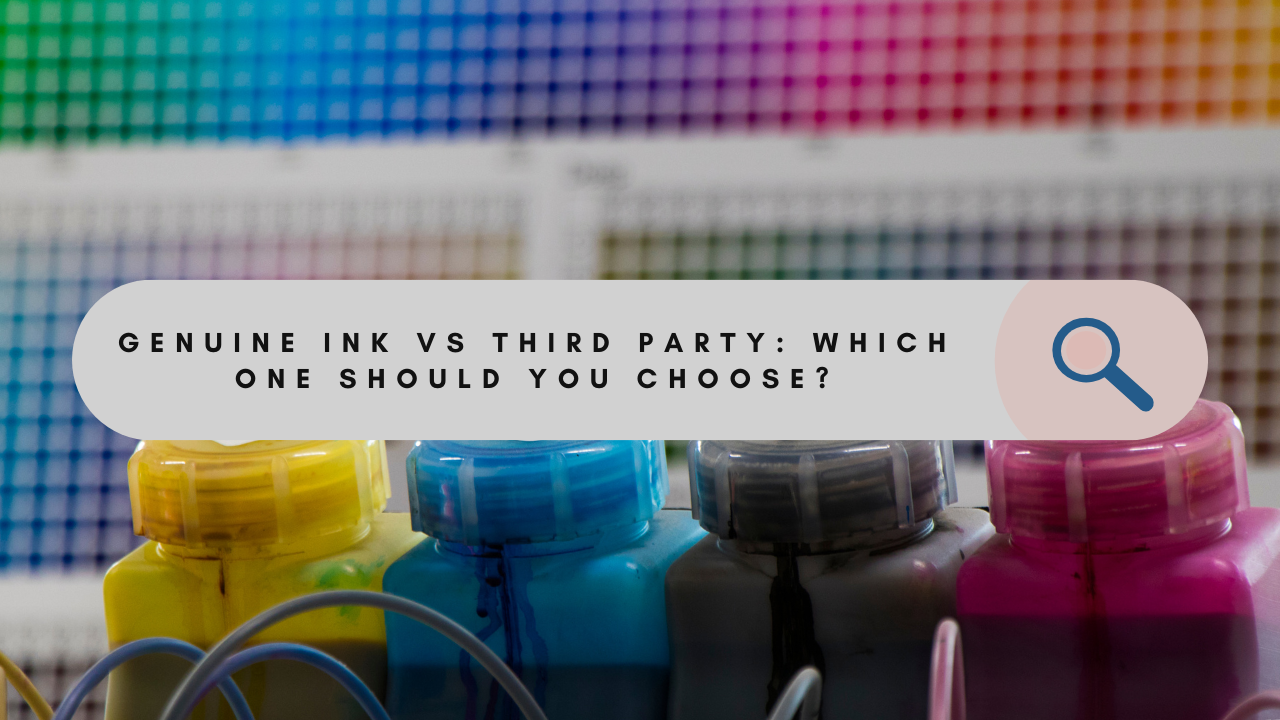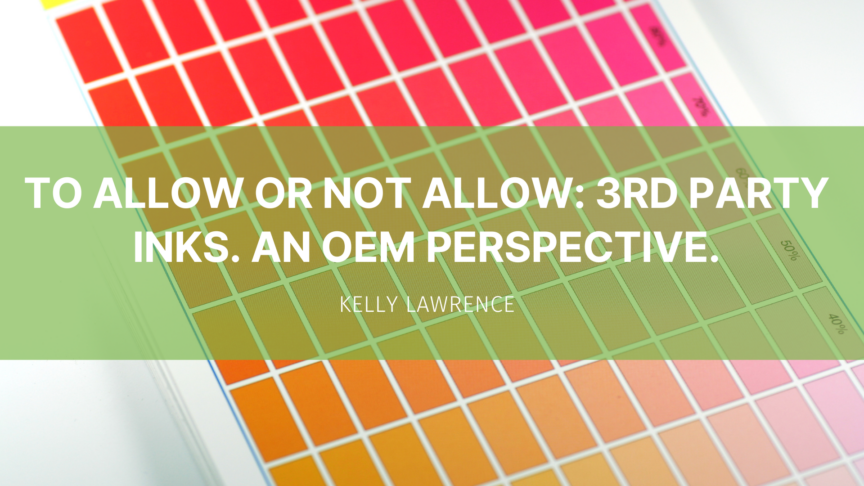
Print industry veterans understand there are a lot of factors that must come together to get a great printed image. Ink is of course a key component to creating a great print. Multiple sources specifically list black printer ink as one of the most expensive fluids in the world. As humans, we have a perspective that third party specialization brings down the cost of a given item. And so, printer OEMs face pressure to allow third party inks to run through their machines. Does the assumption hold true for inkjet inks that third party inks are cheaper? What tradeoffs are made when using a third-party ink? From an OEM perspective, how do you decide if you should or should allow third party inks to be printed through your equipment. This article highlights the pros and cons an OEM must consider when deciding whether to allow 3rd party inks to run through their equipment.
An Exercise in De-risking
 Whether or not to allow third party inks to go through a given print machine is up to the individual printer OEM. Essentially the OEM must decide what level of risk the organization is comfortable with. Will a warranty be issued on the machine? For how long and to what extent? Will the warranty be invalidated if a third-party ink goes through the machine? Assessing risk comes down to understanding both the magnitude and likelihood of a potential problem. In other words, how likely is it for a given problem to occur? If the problem occurs, what is the impact of the problem? Impact is typically measured in cost – both in dollars and in the health and safety of people.
Whether or not to allow third party inks to go through a given print machine is up to the individual printer OEM. Essentially the OEM must decide what level of risk the organization is comfortable with. Will a warranty be issued on the machine? For how long and to what extent? Will the warranty be invalidated if a third-party ink goes through the machine? Assessing risk comes down to understanding both the magnitude and likelihood of a potential problem. In other words, how likely is it for a given problem to occur? If the problem occurs, what is the impact of the problem? Impact is typically measured in cost – both in dollars and in the health and safety of people.
The Impacts of Ink Within the Printing Process
To understand likelihood and magnitude of a potential problem occurring, it can be helpful to consider the different characteristics of a print and the print process that an ink can affect.
Compatibility
Compatibility refers to the interaction of the ink substrate and any topcoats that might go over the print itself. For an OEM to make claims The print system will deliver specific results and that specific substrates and specific topcoats or finishing processes can be used the OEM typically needs to understand the chemistry involved in each layer of a print. If the OEM is manufacturing the ink themselves this data is relatively available and can be easily tested in a print lab. If the OEM allows third party inks the OEM may choose to bring those third-party inks in house for testing and to confirm compatibility within the print system. If, however, an OEM allows third party inks, than the OEM has no way of confirming this compatibility. That’s okay if the print house is aware of the compatibility testing that must be completed. To ensure a good print someone has to be sure of compatibility prior to the printed object going to the end consumer. Typically, the onus of this responsibility has been with the printer OEM vote it could be transferred to the print house.
Dry Time
Dry time refers to how long it takes for the ink to dry to the touch and to be fully cured once printed. Ink manufacturers typically test and report on ink dry time in both scenarios based on print testing they complete. The printer OEM is typically in a good position to do this testing because drying time of the ink can be impacted by the mechanical process by which ink is applied.
Print Head Clogs
Most printers contain more than one print head. Some print heads are relatively inexpensive and while others range in the thousands of dollars per head to replace. Before a printer OEM decides if third party ink will be permitted, the OEM will want to consider the total cost of replacing all the heads if every head were to be clogged. This is a measure of magnitude or impact if an event should arise. However, the likelihood every print head would clog at the same time is likely on the low side. Print heads can clog if the ink dries prematurely in the head or if particle sizes of individual chemistries within the ink are too large. Problems have the potential to be avoided when ink and machine are designed to work together in an optimal way. Printer OEM’s that accept a third-party ink may have specifications in place that an ink must meet to go through the system with minimal risk of causing print head clogs. If an ink is used that does not meet the OEM’s specifications it could lead to problems.
Print Quality
Overall print quality can be affected by the ink itself as well as how the ink is applied onto the substrate and how the ink interacts with the substrate. It is helpful for an OEM to know what the interactions will be to advise print houses as to how they can manipulate system components to get the desired print quality. That said a print house should check print quality for every substrate they print on as substrates are nearly infinite and it would be impossible to expect the printer OEM to check every substrate. In addition, print houses commonly check the print settings for a given job and adjust software and print profiles for different quality requirements and different substrates. Most print houses would expect to own the quality of the print job and would use guidance from the printer OEM for how to optimize that quality. If the printer OEM chooses to allow third party inks, it may limit the quality of the guidance that can be provided. However, this is no different than when a print house asks for guidance on a substrate that the printer OEM has not printed through the printer. There are so many opportunities to fine tune the print system to optimize quality for the desired job requirements that the print house should be able to achieve desired print quality regardless of ink source.
Color Accuracy
Important subset of print quality is color accuracy. Color accuracy of course can be modified based on the profile which is developed within the RIP software. Theoretically, the software adjusts for color accuracy based on the ink the substrate and the desired result. As long as the system is being optimized and each component within the system is consistently used color accuracy should be achievable regardless of ink source.
Contamination
Contamination of an ink is an issue because it impacts quality of the print, can compromise the print system and potentially human health pending the type of contamination. That said, most manufacturers of ink are aware of these challenges and monitor manufacturing processes to reduce the likelihood of contamination. Any reputable manufacturer whether printer OEM or third party should be aware of contamination issues and how quality controls in place to prevent them.
Consistent Quality
Like ink contamination, reputable manufacturers of ink are aware of the need to produce a consistently quality product. These manufacturers will set specifications and have the processes in place to ensure consistent repeatable quality every time. Some manufacturers will be better than others. Some of the highest quality ink production facilities this author has seen around the world are in fact third party ink manufacturers as opposed to printer OEMs. Specialists often have higher quality products than non-specialists. Ink manufacturing is a specialty.
Product Cost versus Total Cost of Ownership
OEM’s need to understand why print houses choose third party inks over the OEM branded ink that has been tested and confirmed to work well within the print machine. A big reason print houses choose third party ink versus OEM manufactured ink is cost. The price per liter from a third-party Inc manufacturer may well be less than the price per liter from the OEM. When considering cost of ink print houses should consider the total cost of ownership. How much ink must be used to achieve the desired print quality on a given substrate? Will the same job require more of a lower cost ink than a higher cost ink? If so, the total cost of ink used should be considered. Does one ink require more printer maintenance? Does the system need to be cleaned or flushed out more resulting in more ink usage? Do print heads need to be cleaned or checked more regularly requiring an increase of operator time? Is downtime increased on the machine for one ink versus another? These factors contribute to the total cost of ownership and should be considered when deciding between an OEM manufactured ink and a third-party ink. Because these are critical decision factors for a print house, printer OEM’s must also be aware of the answers to these questions. These answers result in the overall value proposition and effects how the OEM communicates the value proposition its products have to the print house. Value proposition and the effective communication thereof typically impacts the success or failure of new product launches.
The OEM Guarantee
When selling any product it is common for the seller to make some sort of guarantee to the buyer. In the world of inkjet this guarantee commonly comes in the form of a warranty on the press itself. The OEMs must decide if a warranty will be offered and the terms of that offer. When the OEM does not make the ink, it can be very difficult for the OEMs to guarantee that the ink will work in the machine a certain way. The OEM could choose to test and certify third party inks for the machine, but this of course can be time consuming and costly. Thereby the OEM needs to find a way to pay for this extra cost and remain profitable. Some OEM business models are designed for the OEM to make the majority of profit on the sale of consumables i.e., ink. If an OEM chooses to allow third party ink, the OEM may have to increase the price of the press to enable acceptable profitability to continue operations.
The End Game
Like every decision, there are pros and cons to requiring an OEM ink or allowing a third-party ink to be run through a press. Each OEM must conduct its own risk assessment that considers all the requirements that must be true to achieve success. As discussed above, these requirements may include OEM profitability, how the ink impacts the printing process how the ink impacts total cost of ownership and of course, how the print house customers desire to be served.

